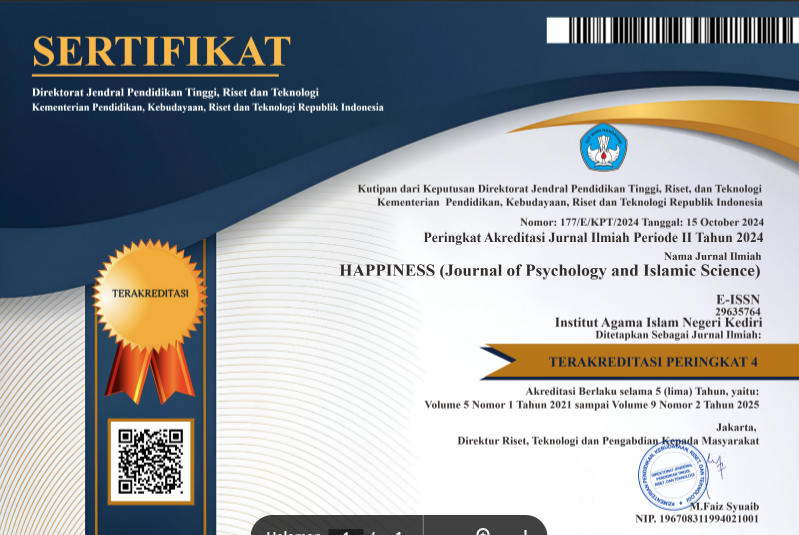Gambaran Resiliensi pada Anak yang Memiliki Keluarga Tiri
DOI:
https://doi.org/10.30762/happiness.v6i2.556Keywords:
Anak, Keluarga tiri, Resiliensi,Abstract
Every child has a desire to have a harmonious family. In reality, not every family can make it happen, because every family has various problems. Problems that occur in the family include divorce, death of a partner and others. Various problems that occur in the family will have an impact on family members, one of which is the child. The purpose of this research is to know the description of resilience in children who have step families. The type of research used in this research is qualitative research with phenomenological methods. Data collection was carried out using interview techniques, using interview guides (guide interviews) and coding the results of the interviews. Subjects were taken based on certain criteria using a purposive sampling technique. Respondents from this study were children who have step families. The results of this study found several categories, namely the relationship with the stepfamily, emotional control, self-acceptance and also the ability to overcome problems within oneself and the family.
Downloads
References
Creswell, J. W. (2009). Research design: Qualitative, quantitative, and mixed methods approaches (3th ed.).
Dariyo, A.(2004). Memahami Psikologi Perceraian Dalam Kehidupan Keluarga. Jurnal Psikologi, 2 (2), 94-100.
Hyoscyamina, D.E.(2011). Peran Keluarga Dalam Membangun Karakter Anak. Jurnal Psikologi, 10 (2), 144-152. Retrieved from https://doi.org/10.14710/jpu.10.2.144-152
Ifdil, & Taufik. (2012). Urgensi Peningkatan Dan Pengembangan Resiliensi Siswa Di Sumatera Barat. PEDAGOGI: Jurnal Ilmiah Ilmu Pendidikan, 12 (2), 115-121. Retrieved from https://doi.org/10.24036/pedagogi.v12i2.2195
Mufidatu Z., & Sholichatun, Y.(2016). Penerimaan Diri Remaja Yang Memiliki Keluarga Tiri. Psikoislamika: Jurnal Psikologi dan Psikologi Islam, 13 (1), 29-37. Retrieved from https://doi.org/10.18860/psi.v13i1.6407
Nugrahani, F. (2014). Metode penelitian kualitatif. Solo: Cakra Books.
Raco, J. R. (2010). Metode penelitian kualitatif. jenis karakteristik dan keunggulannya. Retrieved from 10.31219/osf.io/mfzuj
Ramadhani, P.E., & Krisnani, H.(2019). Analisis Dampak Perceraian Orang Tua Terhadap Anak Remaja. Jurnal Pekerjaan Sosial, 2 (1), 109-119. Retrieved from https://doi.org/10.24198/focus.v2i1.23126
Sari, D.S.P.(2022). Melatih Regulasi Emosi Pada Anak Pra Sekolah Dengan Bermain: Literature Review. Jurnal Pendidikan dan Kebudayaan, 2 (1), 14-20. Retrieved from https://doi.org/10.55606/jurdikbud.v2i1.149
Shidiq, U., & Choiri, M. (2019). Metode Penelitian Kualitatif di Bidang Pendidikan. In Journal of Chemical Information and Modeling, 53( 9)
Sugiyono. (2013). Metode penelitian kuantitatif, kualitatif, dan R& D. Bandung: Alfabeta
Suyasa, P.T.Y.S., & Wijaya, F.(2006). Resiliensi Dan Sikap Terhadap Penyalahgunaan Zat (Studi Pada Remaja). Jurnal Psikologi, 4 (2), 103-118.
Utami, I.B., Hardjono., & Karyanta, N.A. (2014). Hubungan Antara Optimisme Dengan Adversity Quotient Pada Mahasiswa Program Studi Psikologi Fakultas Kedokteran Uns Yang Mengerjakan Skripsi. Jurnal Ilmiah Psikologi Candrajiwa, 2 (5), 154-157.
Wardyaningrum, D.(2013). Komunikasi Untuk Penyelesaian Konflik Dalam Keluarga: Orientasi Percakapan Dan Orientasi Kepatuhan. Jurnal AL-AZHAR INDONESIA SERI PRANATA SOSIAL, 2 (1), 47-58.
Yusuf, M. (2014). Metode penelitian: Kuantitatif, kualitatif, dan penelitian gabungan. Jakarta: Prenadamedia Group.
Downloads
Published
How to Cite
Issue
Section
License
Copyright (c) 2022 Khairani Melyana

This work is licensed under a Creative Commons Attribution-ShareAlike 4.0 International License.





















